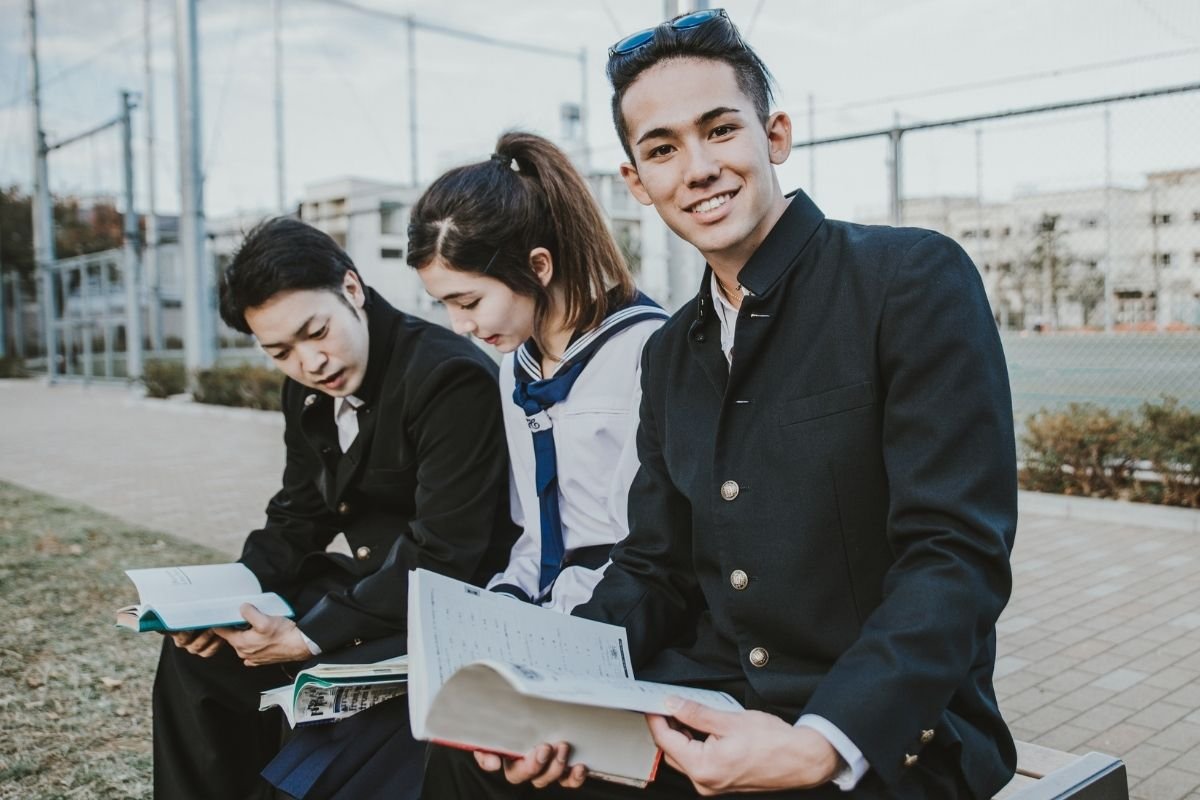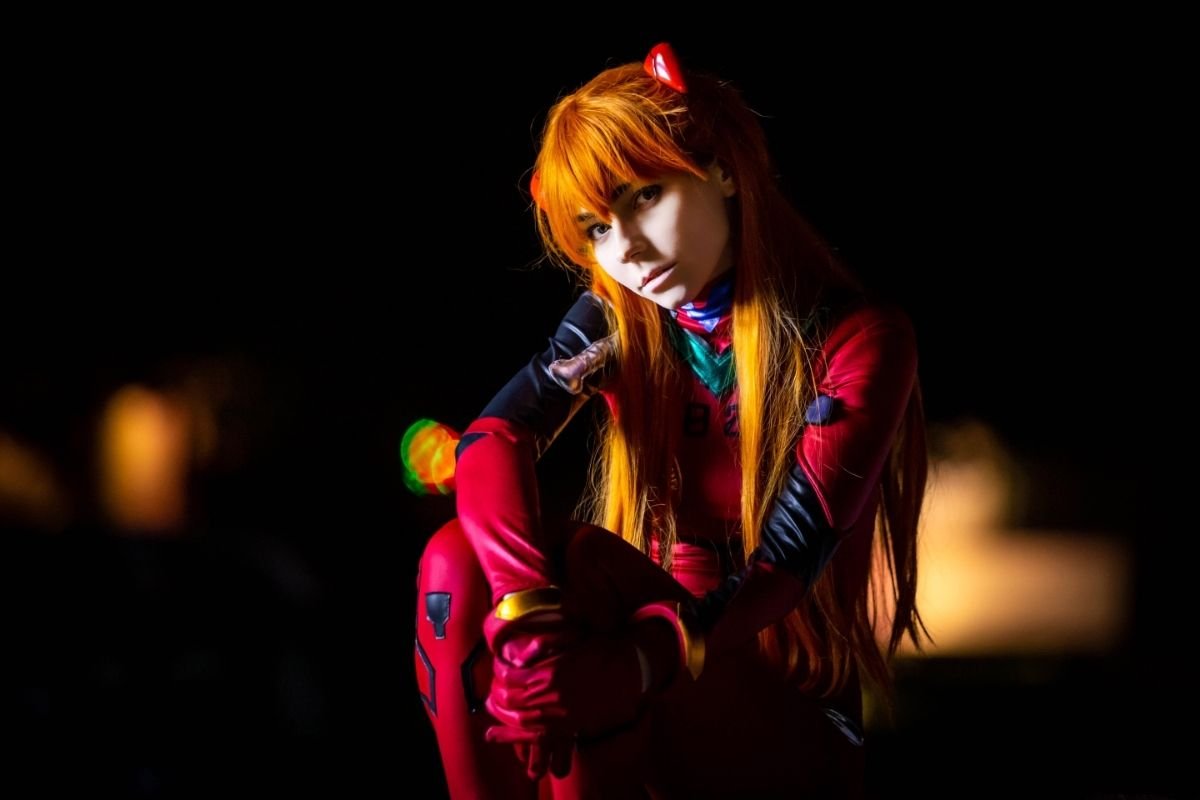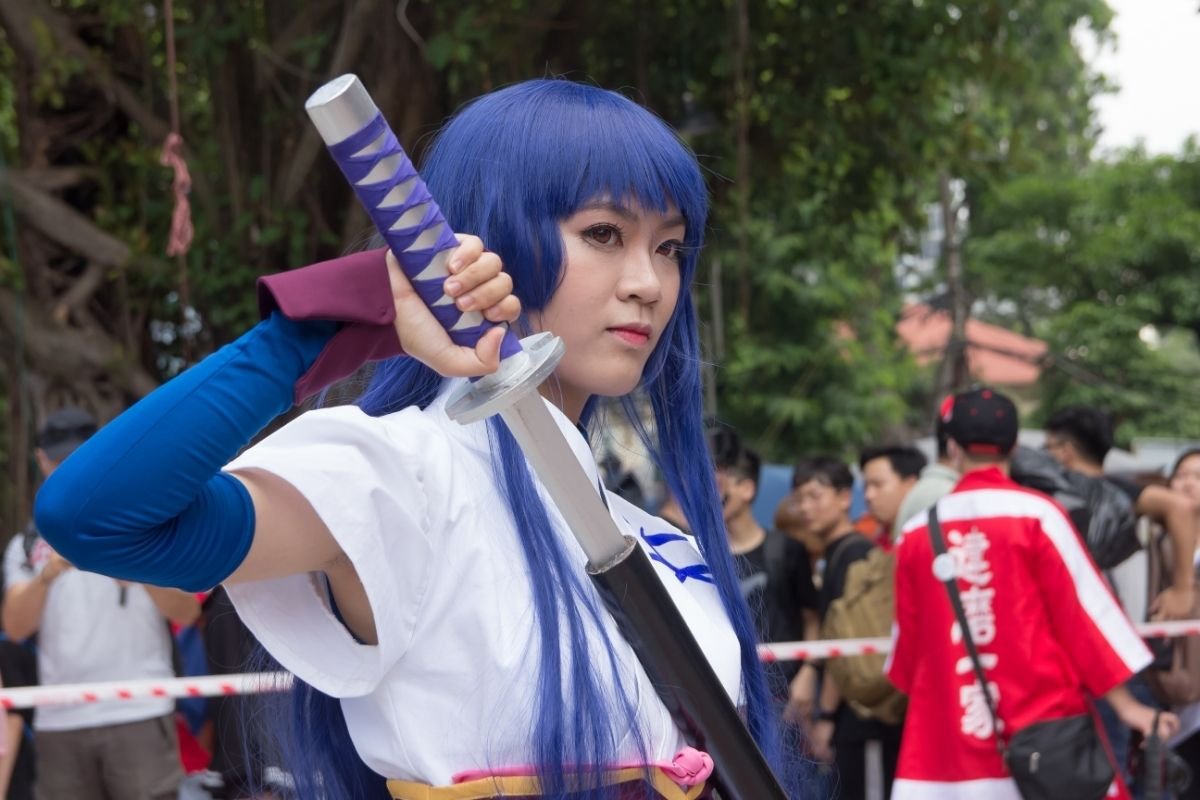Though you might think wearing a uniform to school is a pretty standard thing – especially in countries like the UK – the iconic school uniforms of Japan stand out from the crowd.
In Japan, uniforms are generally required in middle and high school for both public and private schools. However, some private schools also require elementary children to wear uniforms.

Uniforms, known as seifuku in Japanese, were first introduced in the late 19th century. If you’re familiar with anime or manga (see also ‘Best Isekai Manga’), you may already be familiar with typical Japanese uniforms. Traditionally, male students wear a military-style uniform and girls wear a sailor outfit.
However, Western-style Catholic school uniforms are also pretty common.
As you can imagine with most uniform-wearing schools, there is also a strict dress code, as students aren’t permitted to have or wear makeup, piercings, outrageous hairstyles, or unnatural hair.
This simple, quite innocent look has become an iconic symbol of Japanese youth culture.
In this article, we’re going to look at the history, culture, and different styles of Japanese uniforms, as well as how modernity has influenced recent changes in uniform styles.
History
Japanese school uniforms were first introduced in Japan during the Meiji era (1868 -1912). This was when Emperor Meiji opened Japan to the West for trade and business. Before then, Japanese students wore traditional and formal clothing to school.
This was in part because most students before the turn of the Twentieth Century were from wealthy families. Girls typically wore kimonos and boys wore hakama (see also ‘Do Men Wear Kimonos?‘).
Towards the end of the Meiji era and at the beginning of the Taisho period (1912 – 1926) Japan had begun to mix with the Western world, and Japanese culture was heavily influenced by these new countries and their own cultures.
Some of the parts of Japanese life that were influenced the most by Western society included technology, production and products, subculture, fashions, and ways of life. One of the more notable influences happened to be the transformation of Japanese school uniforms.
Early Twentieth Century Uniform Styles
Boys no longer wore hakama, instead, they began to wear gakuran. It was derived from the Prussian army uniform (see also ‘Does Japan Have An Army?‘), and its name is a blend of gaku (to study or student) and ran (the Netherlands or the West in general). The name of the uniform translates to “Western-style clothes for students”.
Gakuran consists of a top that has a stand-up collar and five golden buttons, and straight-legged pants. It typically comes in either black or navy and was traditionally worn with a hat too.
Today, many schools still choose gakuran as a uniform for male students, and little has changed in terms of style or color. However, when it was first introduced boys typically wore hats and traditional Japanese sandals called geta.
The girls on the other hand had a pretty different uniform in comparison. At first, they began to wear hakama in bright colors. They also wore big leather boots and their hair tied back with a bow. However, the hakama remained popular only during the Taisho era.
Whereas male uniforms have relatively remained the same, female uniforms have undergone several changes over the decades.
The first massive change came quite quickly, and the hakama was soon replaced with military-styled naval uniforms. Also known as the sailor suit or sailor fuku, this uniform was based on European naval uniforms and was designed by Utako Shimoda in the 1920s.
One of the reasons it was so popular was that it was easy to sew and consisted of very few elements. The first is a short-sleeved white blouse with a sailor-style collar, pleated skirt, kerchief (either bow or tie), white/navy/black socks, and loafers.
Like gakuran, sailor suits are also still extremely popular today. If you’re a manga fan you’ve probably seen the iconic sailor fuku uniform in several manga, including the likes of Sailor Moon and Kagome.
Uniforms In Today’s Japan
As noted, gakuran and sailor suits are still extremely popular Japanese uniform options today. However, there have been several other Western influences on Japanese uniforms.
The Western Catholic school uniform, which typically consists of plaid skirts, blazers, and knee-high socks, has also played a massive role in what Japanese uniforms consist of and is another extremely popular uniform style alongside gakuran and sailor fuku.
No matter what uniform a particular school assigns, however, each school has a specific summer and winter uniform.
As you can imagine, summer uniforms are typically lightweight and relatively simple, especially as Japanese summers are notoriously hot. Boys usually wear a white shirt and slacks, whereas girls wear blouses and skirts.
There’s also a casual sports uniform which normally consists of a t-shirt and shorts in the school color.
As for winter, uniforms are more professional and have heavier materials. Catholic-inspired uniforms normally have a blazer jacket in winter to help students keep warm. In terms of sports kits, students usually have a tracksuit that can be worn over the summer kit.
As mentioned a lot of schools also regulate footwear, book bags, makeup, piercings, hair colors, and hairstyles. However, a lot of these rules have been relaxed in recent years, and some schools only apply these rules on special days like school picture days.
It’s also pretty common to see Japanese kids and teens wearing their uniforms outside of school – even on the weekend! As for younger Japanese children, most elementary schools do not require uniforms, except private-run or central government-run schools.
Male Uniforms

The most common uniform for boys at both public and private schools in the gakuran. As mentioned, it consists of a high collar shirt with five gold buttons down the front and straight-legged pants.
In most schools the uniform is black, however, some schools opt for navy.
As for shoes most boys wear either black loafers or sneakers. Also, some schools require students to wear collar-pins that have their school emblem or class rank on them. In addition, the gold buttons tend to have the school emblem on them too.
Here’s a cute little fact for you! The second button down on their shirt is the closest button to the heart. Because of that, it’s a common practice for a boy to give their second button to a girl he likes or is in love with.
This practice has become a sort of tradition after a novel by Taijun Takeda featured it.
Female Uniforms
When you first think about Japanese schoolgirl uniforms you probably envision the sailor uniforms. This uniform was first introduced in 1920 and is still a common style in schools across Japan even a century later.
The original design was based on the British Royal Navy uniform at the time, and the uniform has rarely changed since.
As noted earlier it consists of a blouse with a sailor-style collar and pleated skirt. A ribbon is also laced through a loop in the blouse and tied in various ways. The most common colors that this uniform comes in are navy, white, gray, and black. There are often red accents too.
Socks are usually navy or white and are knee-high. Girls tend to wear black loafers.
Nowadays the sailor suit is worn mostly in middle schools, as most high schools have adopted the blazer and plaid skirt that Western schools – particularly schools – a favor.
Modern Uniforms
Although gakuran and sailor fuku are relatively popular styles even today, a lot of schools have switched to Western Catholic school style uniforms.
These typically consist of white shirts, blazers, ties, tailored trousers for boys, and plaid skirts for girls.
Although uniform rules can be very rigid in Japan, like most countries that favor uniforms, some students have the opportunity to express their individualism whilst wearing their uniforms.
For instance, some students shorten their skirts, wear badges on their blazers and shirts, or remove the ribbons from their sailor suits. Some even wear makeup or dye their hair a cool color.
This is not a relatively new concept, however, as teens have found ways to express their individuality for decades whilst slightly bending their school uniform codes.
What’s interesting, however, is that as modern society continues to develop more and more schools are choosing to abandon their uniform requirements completely!
In a lot of cases, it’s pretty normal for students to follow a dress code or wear something which resembles a uniform whilst still expressing their individuality. This is a very small trend, however, in comparison to the entire school population of Japan.
Overall, uniforms in Japan are pretty serious business. Rules must be followed, skirts will be measured, buttons will be counted, faces and hair are supposed to be as natural as possible. Not only are uniforms meant to be perfect on school grounds, but outside of school too.
Shoes Are For Outdoors Only
To protect the floors and keep them clean, shoes are not worn indoors. This doesn’t just extend to school, but across Japanese society. To wear your shoes in someone else’s house is considered rude.
School children have a pair of slippers that they keep in cubbies and put on as soon as they’re in school.
Universities
Like universities across the globe, Japanese universities are not bound by uniforms, and for most Japanese students this is the first time since elementary school that they can wear their clothes.
This allows them to express themselves, and a lot of students – like most students across the world – enjoy purchasing new clothes and accessories to show off their style.
Western Appeal
If you’re an American with a passion for Japanese culture, chances are you’ve seen someone at Comic-Con or another cosplay event dressed in a Japanese uniform. This is because a lot of manga characters wear Japanese uniforms.
As mentioned earlier, characters such as Sailor Moon and Kagome wear the traditional sailor fuku. Modern Japanese uniforms can be seen on characters like Vampire Knight and Magi Madoka Magica.
Final Thoughts
Clothing in Japan is pretty unique. The country has a long history and culture surrounding their traditional clothing, but when it comes to school uniforms the country has taken a rather Western approach.
This is largely in part to Western imperialism, but there is still something so inherently Japanese about the uniform styles.
As modern society continues to challenge traditionalism, the Japanese school uniform is likely to remain an iconic symbol of Japanese youth culture for several years to come.
- What Is a Maiko? - July 13, 2025
- What Does Domo Arigato Mean? - July 12, 2025
- What Does Naruto Mean? - July 12, 2025









